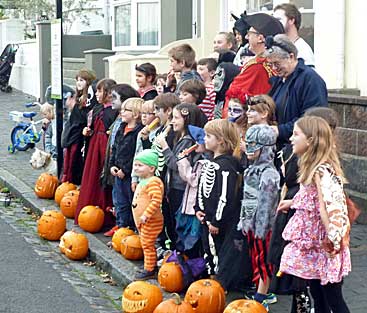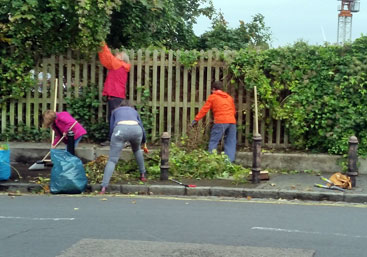Mayo Road
After reading this page, try the 19-question quiz
See also the Mayo Road section on pages 28-31 of the proposed update for Round Hill's conservation character statement:
1881 Properties on Princes Road, Round Hill Crescent (with three properties in Upper Lewes Road) and Mayo Road were first numbered, and properties on Richmond Road , Ashdown Road and D’Aubigny Roads were renumbered.
General Comments
Mayo Road links Richmond Road to Prince's Road.
The street is probably named for The Honourable Robert Bourke and Newnham Winstanley. Bourke’s father was the 5th Earl of Mayo and his elder brother acceded to become the 6th Earl. Bourke purchased adjacent land in Richmond Road for the construction of substantial villas. It is a short street with unusual dark blue brick paviors. These complement the colour of the blue-grey granite kerbs and granite gutter sets which can be found in Mayo Road and in other locations in the conservation area.

Mayo Road achieved notoriety as being the home of the largest laundry in Round Hill. The 1891 census shows 8 laundresses living in the street two of whom were the daughters of the rural postman living at 6 Mayo Road. The owner of Mayo Laundry, Mr H. Winter, is not listed as living at 6 Mayo Road until 1895.
Mayo Laundry closed in the mid 1980s to be replaced by Mayo Court, a 32-flat development.
Streetscape
Mayo Road, Brighton: Type 1 column.
Mayo Court (west side)
Villa pair 29 & 31 Richmond Road replaced by a wing of Mayo Court. Mayo Laundry closed down, giving way to a 32 flat development, in the mid 1980s.
On the corner with Richmond Road is a block of modern flats, Mayo Court, which although constructed from brick has at least some details (e.g. canted bays & pitched roofs) which help to merge the new development into the existing streetscape.
1-5 (consec.) (west side)
The buildings on the west side form a short terrace of two storey houses again with canted bays. These houses date from 1879 and were built by Scrace and German.
The Mayo Laundry at no. 6 Mayo Road was demolished in 1984.
7-16 (consec.) (east side)
The buildings on the east side of Mayo Road are terraced, of three storeys with two storey canted bays. Nos. 7-13 were designed by Stenning and Denman date from 1880 and 14 and 15 designed by the same architects date from 1881.

The Victoria Inn, first listed in 1891 in Pages Directory, (later The New Vic very briefly from the 1990s to the pub’s closure in 2008)—English Domestic revival/ Queen Anne style. Pargetting (decorative plasterwork panels) shown in early photographs has been lost.

In 2010, The Victoria was converted into two dwellings.

Occupations
The 1891 census shows a railway signalman and a carriage cleaner living at no.1. There are two platelayers (responsible for track laying and maintenance) living at no. 7 and a third one living at no. 13. There are carmen (responsible for repairs and restoration of different kinds of vehicles) living at nos. 3 and 4 and postmen (one town and one rural) living at nos. 5 and 6.
Mayo Laundry owner Mr H. Winter is not listed as living at 6 Mayo Road until 1895, though by 1899 he is listed as living at both 5 and 6 Mayo Road. He was not alone in the laundry industry in Mayo Road.
The 1891 census shows 8 laundresses living in the street. Two are the daughters (aged 22 and 20) of the rural postman living at number 6 Mayo Road. Two (aged 26 and 63) live at 8 Mayo Road. The remaining four, related to Henry Bollen a 70-year-old cordwainer (shoemaker), live with him at 10 Mayo Road. One is his 43-year-old wife and the others are his 3 daughters (aged 36, 28 and 25).
Community
Mayo Road has been a good venue for social gatherings since the closure of the junction with Richmond Road in 2003. The absence of through traffic has meant that (with residents’ consent) the road can be closed off for a couple of hours on occasional Sundays for social events. There have been several Round Hill street parties with numerous stalls, two dog shows, and since 2014 (except for the Covid period) there have been street play sessions from spring to Halloween.


There were approximately 25 such sessions between 2014 and 2019. After Covid, street play has been continued and combined with activities such as plant sales and water fights. The halloween street play has proved to be the most popular.
The local residents’ association, The Round Hill Society, has also organised spring and autumn clean-ups. Mayo Road gets its full share of attention, mainly because of the need to manage overgrown ivy at the junction with Princes Road.

This offers a good opportunity for all age groups to take pride in their surroundings. The challenge is to remove sufficient ivy to clear the concrete ledge where parents can sit during play street sessions, but to leave enough ivy to screen Mayo Road and Princes Road from the Centenary Industrial Estate and Hollingdean Depot.

Mayo Road has also been a focal point of community clean-ups, mainly because of the need to control overgrowth of ivy at the junction with Princes Road.
When the houses were built.
1879 1-6 Mayo Road.
1880 7 - 13 Mayo Road.
1881 14 & 15 Mayo Road.
Round Hill history texts
Ashdown Road | Belton Road | Crescent Road | D'Aubigny Road | Ditchling Road | Lennox Passage (The Cats Creep) | Mayo Road | Princes Crescent | Princes Road | Richmond Road | Round Hill Crescent | Round Hill Road | Round Hill Street | Wakefield Road